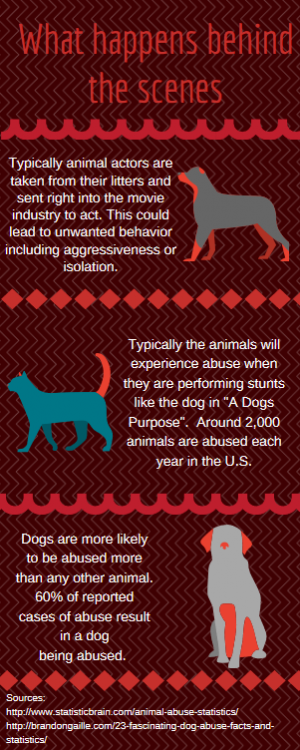‘A Dog’s Purpose’ raises questions about animal abuse in movies

Over the years, many filmmakers have used, “No animals were harmed” disclaimer in their films. Little do people know what these filmmakers have gotten away with on film and behind the scenes. With animal abuse still happening behind the scenes, the films should not be able to use the “No animals were harmed” disclaimer if animals are still abused in the film.
On Jan. 18 footage was released by TMZ; a German shepherd being forced into a pool with rushing water during a shoot for the new movie “A Dog’s Purpose”. The dog was extremely distressed and appeared to be drowning at the end of the video. They may still be able to use the disclaimer “No animals were harmed” even though they have video proof that the German shepherd was traumatized.
Animals have been abused or killed in film since the beginning of movie’s popularity. In 1903 a short film was created by Thomas Edison. The film was titled “Electrocuting an Elephant”, and it depicted what the title states, an elephant being electrocuted to death. The pain and suffering of the elephant was seen as entertainment for the American people.
This is unfortunate that the American people saw the mistreatment of animals as entertainment, but that is what it was like back in the day. Today the mistreatment of animals should not be seen or heard about on film.
Senior Dan Hammer said, “I think it’s kind of ok back then because earlier people would pay to see odd things like the circus, but in today’s world we don’t like to see animals hurt.”
Although in the earlier years of Hollywood it was more likely for films to perform more dangerous stunts because of the lack of CGI technology. The “No animals were harmed” disclaimer is still used on the big screen today. Today the harm happens behind the scenes. According to a group of reporters from the A.V. Club, in the family friendly movie Flicka (2006) a horse was killed on set and in the critically acclaimed Life of Pi a tiger on set almost drowned. Despite the death of a horse and near drowning of a tiger, they still used the “No animals were harmed” in the disclaimer.
The disclaimer should not have been used because an animal was harmed in the making of the film. Even if they did not intend to hurt the animal, the disclaimer should not be used because they still harmed an animal in making the film.
Health teacher Erin Nickelby said, “It does alarm me [that filmmakers can still use the disclaimer]. It makes me question the process behind them being able to tag the film as them not harming the animals. I wonder if they need to hit certain specifications to whether or not they can use the disclaimer.”
Even though the German Shepherd in “A Dog’s Purpose” may not have been physically harmed, psychological trauma may have taken place. The dog had an apparent fear of the water and now that fear has been strengthened by almost drowning.
This abuse behind the scenes should stop. It is taking a toll not only physically but mentally as well. The German shepherd should not be able to go through a stressful event that it did not sign up for.
AP Psychology teacher Gerard Coury said, “I would consider this event as both mental and physical abuse cause animals can experience post traumatic stress disorder the same way humans do.”
Why do filmmakers harm these animals in movies? One will not see people demand tasks from other humans on set. If these tasks are not performed the humans are not disciplined for their actions. For humans the worst thing that could happen is getting fired. Once in awhile a stuntman will die in an accident in the movie but they get paid to put their lives at stake. Animals are still killed much more compared to humans in film and the animals are paid to act not do stunts. In the movie Ben-Hur (1959) over a hundred horses were killed for one scene, and a disclaimer was still used.
Coury explained, “Domesticated animals do things to benefit humans. I don’t know how that benefitted humans. To me that was pure abuse. I understand using animals for research, but that wasn’t for research that was for humans to enjoy.”
The “No animals were harmed” disclaimer should not be used in films that still harmed animals in the film and they should be penalized if they do so. An animal still has a life worth living instead of being a prop in the movie.
Noah Johnson has grown up in the city Stillwater. He loves watching his home state professional sports teams such as the Timberwolves, Vikings and...








Adam Johnson • Mar 28, 2017 at 9:10 pm
This article was really well written. A clear stance was taken and he really brought a serious issue to light with this article, not only that but he reinforced both his viewpoint and the seriousness of this problem really well with his quotes.
Grace McDonough • Mar 28, 2017 at 8:39 am
The article did a great job highlighting the issue and framing the opinion for the reader. The author clearly had researched the topic and provided relative information. The insight of the health and physchology teachers gave a professional perspective while relating the issue to SAHS along with the student perspective.
Craig Sanislo • Mar 28, 2017 at 5:11 am
I thought this was a very interesting article because so few people have any idea of the animals harmed in movies. I thought it was interesting how Mr. Coury was consulted to understand psychological effects on the animals.
Lauren Newman • Mar 27, 2017 at 8:36 pm
I really liked this article because it was very well written and it informed me of an issue that I wasn’t aware of. I liked the author’s strong use of evidence of abuse in this industry and how it has changed throughout the centuries. I also liked how you talked about the mental effects of the abuse of animals and the quotes you used from Mr. Coury.
Max Korth • Mar 27, 2017 at 4:30 pm
This article was very well written and gave insight to something that most people don’t realize is happening in our world today. I also liked in this article how you brought in evidence from films in the early 20th century, and show the change over time.
Kleio Vrohidis • Mar 27, 2017 at 2:51 pm
I really liked reading this article because I think the topic is very important. Many people don’t understand or are unaware of the circumstances animals go through during movies and I think you did a nice job by providing information about the subject. I liked your quotes because it showed how animals are affected by the process rather than just saying it’s unfortunate.
Jack DeGonda • Mar 2, 2017 at 11:49 am
I think that this story is important because it brings to light a very controversial topic- animals being abused in movies. The author used evidence of this occurrence to his advantage well and strong supporting quotes to strengthen the credibility and interest of his story. One problem I had with the story was that similar to his past work, the story is written in the lingua of an elementary school student- I would like to see at least a mix of educational backgrounds from the author.